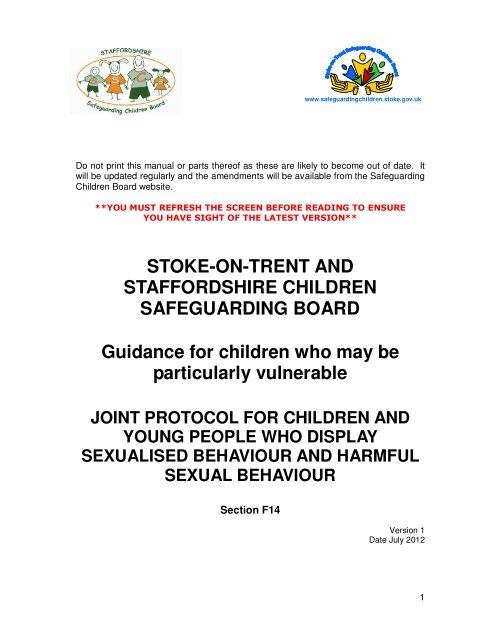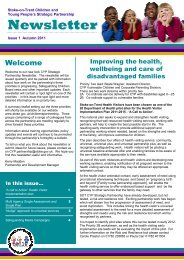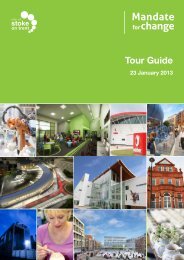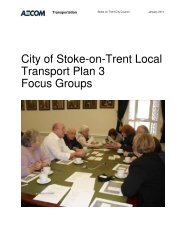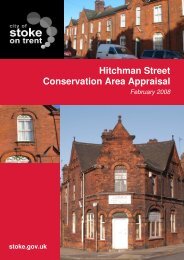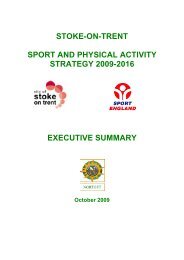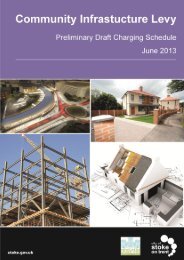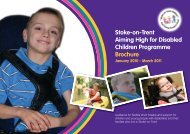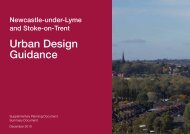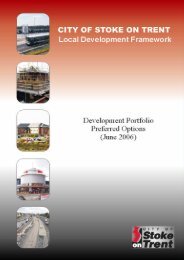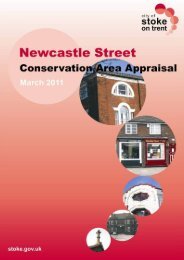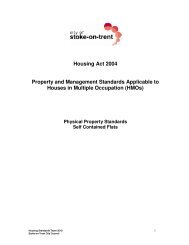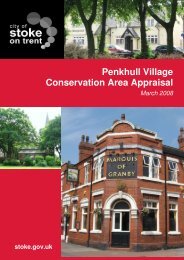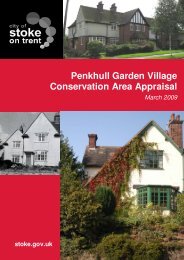CYP who display sexualised behaviour and harmful sexual behaviour
CYP who display sexualised behaviour and harmful sexual behaviour
CYP who display sexualised behaviour and harmful sexual behaviour
- No tags were found...
You also want an ePaper? Increase the reach of your titles
YUMPU automatically turns print PDFs into web optimized ePapers that Google loves.
01 IntroductionIt is recognised that <strong>sexual</strong> exploration <strong>and</strong> experimentation are a normal part ofchildhood development <strong>and</strong> as such these procedures recognise that some childrendo engage in age-appropriate <strong>behaviour</strong>s as part of natural childhood <strong>sexual</strong>development; such <strong>sexual</strong> activity is essentially information gathering characterised bymutuality <strong>and</strong> consent <strong>and</strong> it is not intended that such <strong>behaviour</strong>s fall within the remitof these procedures. For further guidance on healthy, concerning/problematic or<strong>harmful</strong> <strong>sexual</strong> <strong>behaviour</strong>s please refer to Appendix 1, Brook Traffic Light Tool (as at19/3/12) which must always be read in conjunction with their up to date guidance(http://www.brook.org.uk/traffic-lights)Work with children <strong>and</strong> young people <strong>who</strong> abuse others, including those <strong>who</strong> <strong>sexual</strong>lyabuse/offend, should recognise that such children are likely to have considerableneeds themselves, <strong>and</strong> that they may pose a significant risk of harm to other children.Evidence suggests that children <strong>who</strong> abuse others may have suffered considerabledisruption in their lives, been exposed to violence within the family, may havewitnessed or been subject to physical or <strong>sexual</strong> abuse, have problems in theireducational development <strong>and</strong> may have committed other offences. Such children <strong>and</strong>young people are likely to be children in need, <strong>and</strong> some will, in addition, besuffering, or at risk of suffering, significant harm, <strong>and</strong> may themselves be in need ofprotection. Children <strong>and</strong> young people <strong>who</strong> abuse others should be held responsiblefor their abusive <strong>behaviour</strong>, while being identified <strong>and</strong> responded to in a way thatmeets their needs as well as protecting others. (Working Together to SafeguardChildren 2010, page 248, 11.47)The purpose of these procedures is to provide a clear operational framework inrespect of children <strong>and</strong> young people <strong>who</strong> <strong>display</strong> <strong>harmful</strong> <strong>sexual</strong> <strong>behaviour</strong> <strong>and</strong> theiralleged victims. It is important to note that professionals need to remain aware of thenegative effect of labelling children <strong>and</strong> young people as young sex offenders’ or‘young abusers.’ The use of ‘children or young people <strong>who</strong> <strong>display</strong> <strong>harmful</strong> <strong>sexual</strong><strong>behaviour</strong>’ is considered to be more appropriate as this terminology acknowledgesthat their development as a child or young person is the first <strong>and</strong> foremostconsideration <strong>and</strong> that they are <strong>display</strong>ing or enacting <strong>behaviour</strong>(s) that need to beappropriately addressed to work towards change.The primary objective of all work with children <strong>and</strong> young people <strong>who</strong> <strong>display</strong> <strong>harmful</strong><strong>sexual</strong> <strong>behaviour</strong> must be the protection of the victim <strong>and</strong> the prevention of areoccurrence of the <strong>harmful</strong> <strong>sexual</strong> <strong>behaviour</strong>. It is therefore essential for there to be acoordinated, multi-disciplinary response in accordance with statutory guidance <strong>and</strong>these procedures.02 PrinciplesThe following is a guide to key principles that should underpin work withchildren/young people <strong>who</strong> <strong>display</strong> <strong>harmful</strong> <strong>sexual</strong> <strong>behaviour</strong>:3
• To ensure that all children/young people under the age of 18 years <strong>who</strong> <strong>display</strong><strong>harmful</strong> <strong>sexual</strong> <strong>behaviour</strong> towards other children or adults are identified <strong>and</strong>reported by professionals within the multi-agency network.• The needs of children/young people <strong>who</strong> <strong>display</strong> <strong>harmful</strong> <strong>sexual</strong> <strong>behaviour</strong>should be considered separately from the needs of their victims. Theconsequences for the victim should be considered just as seriously as when theabuse is perpetrated by an adult• A holistic child-centered assessment (Framework for the Assessment ofChildren in Need, 2000) should be completed for each child / young person <strong>and</strong>a multi-agency response coordinated to address individual need <strong>and</strong> any riskfactors. The reason why young people <strong>display</strong> <strong>harmful</strong> <strong>sexual</strong> <strong>behaviour</strong> ismulti-faceted <strong>and</strong> needs to be explored further. In all cases child protectionenquiries under section 47 (Children Act 1989) will need to be consideredirrespective of whether abuse is inter-familiar.• Effective inter-agency information-sharing is central to these arrangements.03 DefinitionThe definition of <strong>harmful</strong> <strong>sexual</strong> <strong>behaviour</strong> by children / young people is the same asfor adults <strong>who</strong> <strong>sexual</strong>ly abuse <strong>and</strong> is often characterised by a lack of true consent, thepresence of power imbalance <strong>and</strong> exploitation.“Sexual abuse involves forcing or enticing a child or young person to take part in<strong>sexual</strong> activities, not necessarily involving a high level of violence, whether or not thechild is aware of what is happening. The activities may involve physical contact,including assault by penetration (e.g. rape, or oral sex) or non penetrative acts suchas masturbation, kissing, rubbing <strong>and</strong> touching outside of clothing, They may alsoinclude non-contact activities, such as involving children in looking at, or in theproduction of, <strong>sexual</strong> online images, watching <strong>sexual</strong> activities, or encouragingchildren to behave in <strong>sexual</strong>ly inappropriate ways, or grooming a child in preparationfor abuse (including via the internet). Sexual abuse is not solely perpetrated by adultmales. Women can also commit acts of <strong>sexual</strong> abuse, as can other children”.(Working Together to Safeguard Children 2010 page 38 1.35)The boundary between what is <strong>harmful</strong> <strong>and</strong> what is normal childhood <strong>sexual</strong>exploration/experimentation can be blurred. Appendices 1 & 2 offer guidance forprofessionals making an initial judgement.Abusive <strong>sexual</strong> activity is characterised by <strong>behaviour</strong> that involves coercion, verbal orphysical threats together with secrecy <strong>and</strong> where an individual child or young personrelies on an unequal power base due to such variables as; age difference,underst<strong>and</strong>ing or physical size. The issues of equality, true consent <strong>and</strong> coercion arekey factors within the assessment of whether a child or young person’s <strong>behaviour</strong> isproblematic or <strong>harmful</strong> <strong>and</strong> should be placed within the context of the incident(s) thathave occurred (see Appendix 2).4
Consent IssuesPlease note that if a young person is under the age of 13 years old, under theSexual Offences Act 2003 they cannot legally consent to any form of <strong>sexual</strong>activity. Therefore a child protection referral is required in all such cases.Action in relation to 13, 14 <strong>and</strong> 15 year oldsThe Sexual Offences Act 2003 reinforces that, whilst mutually agreed,non-exploitative <strong>sexual</strong> activity between teenagers does take place <strong>and</strong>that often no harm comes from it, the age of consent should still remainat 16. This acknowledges that this group of young people is stillvulnerable, even when they do not view themselves as such.An assessment should take place of the young person’s competency to give consent<strong>and</strong> of the nature of the relationship. Consider any differences of age, maturity, levelof development, functioning <strong>and</strong> experience <strong>and</strong> also the awareness of the potentialconsequences of their actions. For further information <strong>and</strong> guidance please go toSSCB or Stoke-on-Trent Safeguarding Children Board procedures (see Appendix 5for links <strong>and</strong> contact details) <strong>and</strong> consider the guidance in the Policy‘Working with Sexually Active Young People under 16’) (under review April 2012)A child protection referral or referral to the police is not m<strong>and</strong>atory in all cases of<strong>sexual</strong> activity involving a child under the age of 16 years of age, but an assessment(including whether the children are Gillick competent using Fraser guidelines) in linewith these procedures must be undertaken by the professionals making thesedecisions04 RecognitionIt should be recognised that disclosure of <strong>sexual</strong>ly inappropriate or <strong>harmful</strong> <strong>behaviour</strong>by a child can be extremely distressing not only for the children/young peopleinvolved, but also for parents, carers <strong>and</strong> other family members. They may react withdisbelief <strong>and</strong> minimise the situation which could escalate concerns <strong>and</strong> it is thereforeimportant that professionals help them through this process at an early stage so thatthey can support <strong>and</strong> where appropriate, protect their child.It is also important to remember that not all children/young people <strong>display</strong>ing<strong><strong>sexual</strong>ised</strong> or <strong>harmful</strong> <strong>sexual</strong> <strong>behaviour</strong> have been <strong>sexual</strong>ly abused themselves. Theymay however have been living in an environment with few or inappropriate boundariesor been exposed to information or <strong>sexual</strong> activity which is beyond their natural level ofdevelopment <strong>and</strong> underst<strong>and</strong>ing. Hence in general the younger the child <strong>display</strong>ing<strong><strong>sexual</strong>ised</strong>/<strong>sexual</strong>ly <strong>harmful</strong> <strong>behaviour</strong> the higher the likelihood of that child havingbeen <strong>sexual</strong>ly abused or living in a <strong><strong>sexual</strong>ised</strong> environment. (Wilkinson <strong>and</strong> Carson,2002).5
Harmful <strong>sexual</strong> <strong>behaviour</strong> may also include children <strong>who</strong> exhibit a range of <strong>sexual</strong>lyproblematic <strong>behaviour</strong> such as indecent exposure, obscene telephone calls, fetishism,downloading child abuse images from the internet or exhibit <strong>harmful</strong> <strong>behaviour</strong> againstother children, masturbating in public <strong>and</strong> non contact <strong>behaviour</strong> via informationtechnology.Sexual exploitation is not covered by these procedures. (For more information onworking with ‘Sexual Exploitation of young people’ see procedures on the LSCBwebsites – Appendix 5). See Procedure SOT D1405 ProcedureWhere there is suspicion or an allegation of a child or young person having beenharmed in a <strong>sexual</strong> way by another child or young person, it should be referredimmediately to the children’s social care referral team in the local authority where thechild lives. Both the victim <strong>and</strong> the child <strong>who</strong> has allegedly <strong>display</strong>ed the <strong>harmful</strong><strong>sexual</strong> <strong>behaviour</strong> will need to be referred for assessment - see Appendix 5 for detailsof Staffordshire <strong>and</strong> Stoke-on-Trent contact details.The police are generally the first point of contact when an allegation of <strong>sexual</strong> harmhas been made <strong>and</strong> it is critical for them to always consult with the First ResponseTeam (Staffordshire) or Stoke-on-Trent Children & Young People’s Services Advice<strong>and</strong> Referral Team (ART) regarding cases that come to their attention in order toensure that there is an appropriate assessment of the victims needs <strong>and</strong> of the allegedperpetrator’s needs, including any risk factors within <strong>and</strong> outside the family home (seeAppendix 5 for contact details).On receipt of a referral an initial strategy discussion must occur between Children’sSocial Care Services, the Police <strong>and</strong> Health professionals to share information <strong>and</strong>determine whether the threshold for section 47 enquiry (Children Act 1989) has beenreached. The Police should be involved in the decision making process even if thechild is under ten years old <strong>and</strong> below the age of criminal prosecution as they may, forexample, have information about the child’s family which is relevant to the enquiries.Where the decision is reached within the strategy discussion that the alleged<strong>behaviour</strong> does not meet the threshold criteria for significant harm, the details of thereferral <strong>and</strong> reasons for this decision must be clearly recorded. The outcome shouldalso be appropriately shared with any professionals involved; if the referrer is notprofessional, only limited information can be shared in accordance with inter-agencyinformation sharing arrangements. The need for further assessment <strong>and</strong> supportservices to either child / young person should still be considered within a multi-agencyframework.An Initial Assessment will normally be undertaken by Children’s Services. Theexception to this is if it is apparent from the outset that <strong>behaviour</strong>s are within the scopeof healthy, age-appropriate development; at this stage the First Response Team orStoke ART may offer advice, refer the caller to other universal service provision,advise that an assessment under the Common Assessment Framework (CAF) beinitiated, or conclude that no further action is required.6
Where a section 47 enquiry is required, a different social worker must be allocated forthe victim <strong>and</strong> for the child / young person <strong>who</strong> is suspected or alleged to haveharmed in a <strong>sexual</strong> way, even if they live in the same household, to ensure that bothare supported through the core assessment process <strong>and</strong> that their individual welfare<strong>and</strong> safety needs are being addressed.Where abuse is inter-familial or where the child / young person <strong>who</strong> are alleged tohave harmed <strong>sexual</strong>ly is in the same household, as other younger or more vulnerablechildren, the protection of any other potential victims must be addressed.Consideration should be given for the need to remove the young person <strong>who</strong> mayhave caused the <strong>sexual</strong> harm from the household, at least in the short term.In all cases requiring an initial assessment lateral checks must be undertaken, <strong>and</strong>information about the concerns shared appropriately with organisations, such asschools, so they can manage the risks that a child may pose to others. Lateral checksshould include information in regard to all the children involved. Other organisationsworking closely with children <strong>and</strong> families may need to be consulted at this stage <strong>and</strong>risk management must be borne in mind when decisions around information sharing inthese cases are made. Staffordshire schools/education settings should seek thesupport of an Education Safeguarding Officer in regards to completion of a RiskManagement plan in relation to the child <strong>who</strong> may have demonstrated the <strong>harmful</strong><strong>sexual</strong> <strong>behaviour</strong>.If the threshold for undertaking a section 47 enquiry has not been met, the initialassessments completed by the social workers must indicate whether coreassessments need to be completed in relation to victims <strong>and</strong> the children <strong>who</strong> haveallegedly <strong>display</strong>ed the <strong>harmful</strong> <strong>sexual</strong> <strong>behaviour</strong>. Support needs to be offered to thechildren, young people <strong>and</strong> their families via a coordinated, multi-agency, child in needservice plan or Team around the Child (CAF framework). It is important that allinvolved professionals must be invited to the meetings in order to shareinformation <strong>and</strong> offer a coordinated, multi-agency approach that takes accountof risk to other children <strong>and</strong> young people.Where possible children <strong>and</strong> young people have a right to be consulted <strong>and</strong> involvedin all matters <strong>and</strong> decisions that affect their lives <strong>and</strong> the use of interpreter servicesshould be accessed if needed to achieve this. This right <strong>and</strong> respect extends toparents <strong>and</strong> carers <strong>and</strong> their active participation should be promoted.The NSPCC HSB Service may be able to offer a service to children living withinStaffordshire authority in regard to addressing <strong>harmful</strong> <strong>sexual</strong> <strong>behaviour</strong> <strong>display</strong>ed bya young person. Their referral criteria <strong>and</strong> contact details are specified in Appendix4.06 Strategy Discussion/MeetingWhen a child / young person is suspected or alleged to have harmed another in a<strong>sexual</strong> way, the Police <strong>and</strong> Children’s Services must convene a strategy discussion or,in most cases, a strategy meeting within the required timescales. It is not alwaysapparent at the outset whether a particular <strong>behaviour</strong> is abusive <strong>and</strong> a strategymeeting is an appropriate forum in which to share concerns before reaching a7
collective way forward. The potential complexities of these concerns usually requirethat the appropriate planning takes place in the form of a meeting.When the children / young people concerned reside in differing local authorities, it isrecommended that the strategy meeting is convened <strong>and</strong> chaired by the authority inwhich the potentially <strong>harmful</strong> <strong>behaviour</strong> occurred. In most cases a combined strategymeeting will be convened to share information in respect of the alleged victim <strong>and</strong> thechild/young person <strong>who</strong> is suspected of <strong>display</strong>ing <strong>harmful</strong> <strong>sexual</strong> <strong>behaviour</strong>. Theprimary aim of any intervention should remain focussed on the protection of the victim,the protection of any other potential victims <strong>and</strong> the avoidance of repetition of the<strong>harmful</strong> <strong>sexual</strong> <strong>behaviour</strong>.Strategy meetings will be convened <strong>and</strong> chaired by Children’s Services (social care)<strong>and</strong> a record of the meeting made. It is important that appropriate representation isinvited from relevant organisations working closely with the child <strong>and</strong> family, e.g.Designated Child Protection Persons from the schools that all the children attend.The strategy discussion or meeting must plan in detail the respective roles ofparticipants at the meeting. It also must address ‘risk management measures that maybe required within individual organisations, including voluntary <strong>and</strong> faith. Thediscussion/meeting must take into account the immediate protection of all ofthe children involved <strong>and</strong> any others in contact with the child/young person <strong>who</strong>is suspected or alleged to have harmed others <strong>sexual</strong>ly.If at this stage no further action is required, all agencies <strong>who</strong> have been involvedshould be informed of the outcome in writing. The parents or carers of the children willalso be informed of the outcome of the meeting. Parents or carers should nothowever, receive minutes of the strategy meeting(s).07 Outcomes of Section 47 EnquiriesThe decision about initiating a child protection conference should be made followingthe outcome of the section 47 enquiry. A young person <strong>who</strong> is alleged or suspected tohave <strong>display</strong>ed <strong>harmful</strong> <strong>sexual</strong> <strong>behaviour</strong> should only be the subject of an initial childprotection conference if they are considered to be at risk of significant harm.If a child protection conference is not convened <strong>and</strong> there is an identified need forservices to address the needs of the children concerned, a service plan should bedrawn up in consultation with the young person, their parents / carers <strong>and</strong>professionals. The multi-agency service plan should be subject to review <strong>and</strong> includethe child's need for any work to address their <strong>harmful</strong> <strong>sexual</strong> <strong>behaviour</strong>. Appropriateconsideration should be given to maintaining care <strong>and</strong> education arrangements.Regardless of whether the process followed is through an initial child protectionconference or a multi-agency service planning meeting, it is important that childrenreceive a level of intervention appropriate to their needs <strong>and</strong> risk factors.8
Bibliography DOH Children Act 1989 & 2004 HMSO Working Together to Safeguard Children from Harm 2010 Staffordshire Safeguarding Children Board Procedures; www.staffsscb.org.uk Stoke-on-Trent Children Safeguarding Board DOH (2000): Framework for the Assessment of Children in Need <strong>and</strong> theirFamilies Carson, C & AIM Project (2007):An Initial Assessment & Intervention: For children under 12 years <strong>who</strong> <strong>display</strong><strong>sexual</strong>ly <strong>harmful</strong> <strong>behaviour</strong> Johnson, T.C (1999); Underst<strong>and</strong>ing Your Child’s Sexual Behaviour - NewHarbinger Publications. Brook Organisation - www.brook.org.uk/about-brook Wilkinson, L. & Carson, C. (2002):Guidelines for the Initial Assessment of Children under 10 years old withProblematic Sexual Behaviour – AIM Project Initial Assessment Manual.9
Appendix 1 – The following 4 pages (Traffic LightTool) must be read in conjunction with the guidanceon www.brook.org.uk/traffic-lights/guidanceThese indicators are a guide <strong>and</strong> do notreplace, but should assist the exercise ofprofessional judgement10
Appendix 2When looking at <strong>harmful</strong> <strong>sexual</strong> <strong>behaviour</strong> the following should be considered:• The immediate protection of all of the children involved <strong>and</strong> any others incontact with the child/ young person <strong>who</strong> is suspected or alleged to have<strong>sexual</strong>ly harmed.• Consider the attitude <strong>and</strong> response of parents or carers <strong>and</strong> their ability toprotect their own child/ren. Can they ensure appropriate supervision is in placearound other children?The Behaviour:• Did both parties agree to the <strong>sexual</strong> activity?-Even when those involved are of a similar age; the size, power, level ofassertiveness <strong>and</strong> authority of the young person alleged to have <strong>sexual</strong>lyharmed <strong>and</strong> whether they have a learning difficulty/ disability, mayinfluence the victim’s ability to give informed consent.• Is the <strong>sexual</strong> activity age appropriate?• How frequently has the <strong>behaviour</strong> occurred?• Has the type of <strong>behaviour</strong> changed over time?• Is there evidence of aggression, force, coercion or bribery?• Have the individuals tried to ensure that the <strong>behaviour</strong> remains secret?The child or young person <strong>who</strong> has <strong>display</strong>ed <strong>harmful</strong> <strong>sexual</strong> <strong>behaviour</strong>:• Have there been any previous concerns around <strong>harmful</strong> <strong>sexual</strong> <strong>behaviour</strong> orlack of <strong>sexual</strong> boundaries?• Whether the child / young person <strong>who</strong> is alleged to have <strong>sexual</strong>ly harmedacknowledges their <strong>behaviour</strong> or actions, minimises or denies the allegationsmade.• The likelihood or progress of any criminal prosecution.• Whether there is any evidence or grounds to believe that the child or youngperson <strong>who</strong> is suspected or alleged to have <strong>sexual</strong>ly harmed, has also been thevictim of abuse themselves.The Victim:• What is the age, vulnerability <strong>and</strong> impact on the victim?• Need to consider the victims needs separately.15
Appendix 3PROCEDURE FOR INTERVENTIONS FOR CHILDREN AND YOUNGPEOPLE WHO DISPLAY SEXUALLY HARMFUL BEHAVIOURInformation concerning <strong>harmful</strong> <strong>sexual</strong> <strong>behaviour</strong>or <strong>sexual</strong> offence by a child or young personAppropriate advicegiven to family<strong>and</strong>/orprofessionalsInform relevant Children’sService Referral Team(appendix 5) or the MASH101Referral passed to areasocial work team forStrategy DiscussionStrategyMeeting/discussion re s47investigation. Differentsocial workers allocatedto victim <strong>and</strong> the child<strong>who</strong> has allegedly harmed<strong>sexual</strong>ly. Protection ofvictim <strong>and</strong> other childrenmust be consideredMulti-agencymeeting – completechild in need CoreAssessment or CAFCoreAssessmentscompletedNo furtheractionIndividual agencies tocomplete appropriaterisk assessments/riskmanagement plansInitial ChildProtectionConferenceChildProtection PlanService Plan/CAF/MASTAppendix 416
Introduction & OverviewOfHarmful Sexualised Behaviour Service, NSPCC Service Centre,Carole House,213 Basford Park Road, Newcastle – Under – Lyme, ST5 0PGThe Harmful Sexual Behaviour (HSB) Service, based at NSPCC Service Centre,Carole House, Stoke-on-Trent offers individual assessment <strong>and</strong> treatment of HSB toyoung males, between the ages of 12 – 18 years.Young males, <strong>who</strong> are referred to the NSPCC Service Centre, will be assessed bypractitioners from the HSB Service using the AIM 2 Assessment. The AIM 2assessment is designed to assist in the assessment of young males of mainstreameducational ability, aged between 12 <strong>and</strong> 18 years, <strong>who</strong> are known to have presentedproblematic <strong>sexual</strong> <strong>behaviour</strong> or where <strong>harmful</strong> <strong>sexual</strong> <strong>behaviour</strong> has occurred. Theprocess of assessment is focused on the four domains of; development, family,environment <strong>and</strong> <strong>sexual</strong> <strong>and</strong> non-<strong>sexual</strong> <strong>harmful</strong> <strong>behaviour</strong>s.The assessment focuses on issues which are evidentially linked to the risk of <strong>harmful</strong><strong>sexual</strong> <strong>behaviour</strong>s, as well as considering factors such as lack of empathy <strong>and</strong> qualityof relationships which are shown to have impact on the likelihood of further HSB. Aswell as working with the young person, practitioners will work with parents/carers inorder to establish a cleared underst<strong>and</strong>ing of the young person, their background,significant experiences which may contribute to the <strong>behaviour</strong>s which attributed totheir referral to the NSPCC.Following AIM 2 assessment practitioners will provide the young person <strong>and</strong> theirparents/carers with a report which covers all the aspects of the assessment, alongwith consideration of need with regards to the treatment programme provided by theNSPCC.For young people considered in need of the treatment programme, will be offeredbetween 26 – 30sessions. The HSB treatment programme has two broad aims. Thefirst aim is to help young males develop strategies so that they do not <strong>sexual</strong>ly harmothers <strong>and</strong> are able to have healthy <strong>sexual</strong> relationships in the future. Secondly, thetreatment will help young people deal positively with problems <strong>and</strong> enhance their selfesteem.The treatment will enable young people to build constructive <strong>behaviour</strong>. Focusing onstrengths rather than apportioning blame, the treatment sessions draw togetherclinically established approaches <strong>and</strong> address the young person’s thoughts, feelings<strong>and</strong> <strong>behaviour</strong>s.17
Young people not considered as in need of treatment intervention, following the AIM 2assessment can occasionally be provided with some individual sessions focused onspecific issues which may require additional support. Intervention with young peoplereferred to the HSB service seeks to help young people underst<strong>and</strong> <strong>and</strong> move on fromnegative experiences, which they may have encountered during their life.The HSB team works closely with key agencies including Children <strong>and</strong> Familiesservices, Education, Police <strong>and</strong> Youth Offending Services, in order to ensure that amulti-agency approach is in place whilst working with this group of young people <strong>and</strong>their families/carers .Referrals to the HSB service can be made by contacting the NSPCC Service Centre.Young people considered as appropriate referrals to the HSB service are as follows;• Boys <strong>and</strong> young men (aged 12 –18) <strong>who</strong> have <strong>display</strong>ed <strong>harmful</strong> <strong>sexual</strong><strong>behaviour</strong>• Boys <strong>and</strong> young men <strong>who</strong> do not have a diagnosed learning disability• Boys <strong>and</strong> young men <strong>who</strong> may have a diagnosed learning difficulty, but<strong>who</strong>se levels of comprehension enables them to manage written workwhich would be considered to be within the remit of ‘main stream’education.• Referrals are taken from all Children’s Service Teams, Youth Offending<strong>and</strong> Educational Provisions within the Staffordshire <strong>and</strong> Stoke-on-Trentareas, where the young person meets the above criteria.Contact Details:NSPCC Service Centre,Carole House,213 Basford Park Road,Newcastle – Under – Lyme,ST5 0PGTel: 0844 892 027318
Appendix 5Contact detailsChild living in Stoke-on-Trent Local Authority:ART (Advise <strong>and</strong> Referral Team)Children & Young People’s Services Vulnerable Children <strong>and</strong> Corporate ParentingSwann HouseBoothen RoadStoke on TrentST4 4SYTel. 01782 235100Fax. 01782 235457Emergency Duty Team (EDT) (outside office hours) - 01782 2342340Stoke-on-Trent Safeguarding Children Board Procedures:www.safeguardingchildren.stoke.gov.ukChild living in Staffordshire Local AuthorityFirst Response TeamMulti Agency Safeguarding Hub (MASH)Lindum HouseStoneStaffordshireST15 0SDTel. 0800 1313 126Emergency Duty Team (outside office hours) – 0845 6042886Fax 01785 854223e-mail firstr@staffordshire.gov.ukStaffordshire Safeguarding Children Board:www.staffsscb.org.ukStaffordshire Police – Staffordshire <strong>and</strong> Stoke-on-TrentTel. 101 <strong>and</strong> ask for M.A.S.H. (Multi-agency safeguarding hub)Alternative phone number for Police (April 2012) 0300 123 4455 but this willreplaced by the 101 number in due course.be19


